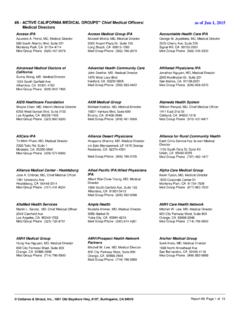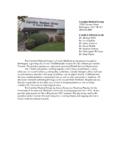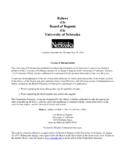Transcription of Medical Physiology Learning Objectives
1 Medical Physiology Learning Objectives Robert G. Carroll L. Gabriel Navar Mordecai P. Blaustein Published jointly by The American Physiological Society and the Association of Chairs of Departments of Physiology Permission to reproduce the information in this publication is granted for classroom, home, or workshop use only. For all other purposes, request permission in writing from the Education Office at The American Physiological Society. Use Notice: This material is available on the web at (APS web site). or (ACDP web site).
2 APS Education Publication Number 2012-01. 2012 by The American Physiological Society (APS). Education Office 9650 Rockville Pike Bethesda, MD 20814-3991. 301-634-7132. 301-634-7098 (fax). Association of Chairs of Departments of Physiology (ACDP). 9650 Rockville Pike, Suite 314. Bethesda, MD 20814-3991. 301-634-7785. 301-634-7098 (fax). Cover design by Alta E. Wallington Medical Physiology Core Learning Objectives Project Revised February 2012. The American Physiological Society/Association of Chairs of Departments of Physiology 2.
3 TABLE OF CONTENTS. Introduction and Rationale 6. Authoring Committee Membership .. 7. Special Thanks to Faculty at These Institutions .. 8. Learning Objective Format ..9. Learning Objectives and Template .. 10. Tips for Constructing Learning Objectives .. 10. Cardiovascular Unique Characteristics of Cardiac Muscle .. 12. Electrophysiology of the Heart .. 12. Cardiac Function .. 13. Cardiac Cycle .. 14. Physiology of Cardiac Defects (Heart Sounds) .. 15. The Normal Electrocardiogram (ECG) and the ECG in Cardiac Arrhythmias and Myopathies.
4 15. Cardiac Output and Venous Return .. 16. Fluid Dynamics .. 16. Arterial Pressure and the Circulation .. 17. The Microcirculation and Lymphatics .. 18. Regulation of Arterial 19. Local Control of Blood Flow .. 20. Fetal and Neonatal Circulation .. 21. Hemostasis and Injury, Hemorrhage, 21. Coronary Circulation .. 22. Cerebral, Splanchnic and Cutaneous Circulation .. 22. Exercise .. 23. Cell and General Biological Membranes, Solutes and Solutions .. 24. Excitable Cells .. 26. Cell Volume Regulation, Cytosolic pH, and Organelles.
5 27. Regulation of Cell Function .. 27. Epithelia .. 27. Cell Motors .. 28. Transcapillary Transport .. 28. Medical Physiology Core Learning Objectives Project Revised February 2012. The American Physiological Society/Association of Chairs of Departments of Physiology 3. Endocrinology and Metabolism General Principles .. 29. Pituitary Gland Posterior .. 30. Pituitary Gland Anterior .. 30. Growth Hormone .. 30. Thyroid Gland .. 31. Hormonal Regulation of Calcium and Phosphate .. 31. Adrenal Gland .. 32. Metabolism.
6 33. Pancreas .. 33. Endocrine Integration of Energy and Electrolyte Balance .. 34. Reproductive Physiology Male .. 34. Reproductive Physiology Female .. 35. Pregnancy and 36. Sexual Differentiation .. 36. Gastrointestinal Functions and Regulation of GI Tract .. 37. Salivary Glands .. 38. Esophagus .. 38. Stomach .. 39. Exocrine Pancreas .. 40. Hepatobiliary .. 40. Small Intestine .. 41. Large Intestine .. 42. Gastrointestinal Motility and Enteric Nervous System .. 43. Exercise and Integration 44. Exercise .. 44.
7 Muscle General Principles for Skeletal, Cardiac, and Smooth Muscle .. 46. Skeletal Muscle Structure and Mechanism of Contraction .. 47. Control of Skeletal Muscle Contraction: Excitation-Contraction Coupling and Neuromuscular Transmission .. 47. Mechanics and Energetics of Skeletal Muscle Contraction .. 47. Smooth Muscle .. 48. Cardiac Muscle .. 48. Medical Physiology Core Learning Objectives Project Revised February 2012. The American Physiological Society/Association of Chairs of Departments of Physiology 4. Neurophysiology Cellular Neurophysiology, Blood Brain Barrier, Cerebrovascular Physiology .
8 50. A. Physiology of the Neuron .. 50. B. Neurochemistry .. 51. C. Cerebrovascular System .. 52. D. Cerebrospinal Fluid, Blood Brain Barriers .. 52. Sensory Processes .. 53. A. Somatosensory System .. 53. B. Visual 55. C. Smell and Taste .. 58. D. Auditory System .. 59. E. Vestibular 60. Effectors and Command Systems .. 62. A. Autonomic Nervous System .. 62. B. Descending Control of 63. Sensorimotor Integration and Internal Regulation .. 64. A. Spinal Cord - Brainstem 64. B. Diencephalon Function .. 65. Brain and Behavior.
9 66. A. Cerebral Cortex .. 66. B. Cerebellum .. 67. C. Basal Ganglia .. 68. D. Limbic System .. 68. E. Sleep .. 69. F. Seizure Activity .. 69. Physiological Assessment of the PNS and CNS .. 70. A. Nerve Conduction/EMG Studies .. 70. B. Electroencephalogram .. 70. C. Electrooculogram .. 70. D. Brain Imaging Techniques .. 70. E. Proteomics and Genomics .. 71. F. Gait Analysis .. 71. Renal Body Fluids .. 72. Structure of the Kidney and Nephrons .. 72. Renal Clearance .. 73. Glomerular Filtration Rate and Renal Hemodynamics.
10 73. Transport Properties of Nephron Segments .. 75. Urine Concentration and 75. Na+ Balance and Regulation of Extracellular Fluid Volume .. 76. K+ Balance .. 77. Ca2+ and Phosphate Balance .. 77. Acid-Base Balance .. 78. Integrative and Pathophysiological Aspects; Hypertension .. 79. Medical Physiology Core Learning Objectives Project Revised February 2012. The American Physiological Society/Association of Chairs of Departments of Physiology 5. Respiration Pulmonary 80. Alveolar Ventilation .. 81. Pulmonary Circulation.






